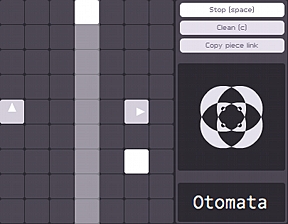

But please do the math, it is possible (but not proven) that there might exist some configurations where the exact repetition would take (billions of billions of times) longer than the known age of our universe. I should have said “(practically) never repeating” above. I’d love it if you give some sort of attribution, still cool if you don’t do it.Ĭ: You are a filthy liar! You can’t create “never repeating” patterns with a system whose state space is finite!Ī: You are right.

Q: Can I use the output in my own piece, am I allowed to do that?Ī: By all means do so! Hell do it even if I said no.
OTOMATA MUSIC ON YOU CODE
Also the code needs a bit of clean-up to be meaningful.Ĭ: I found this bug where the cells move in circles. I wasn’t who Chrishell planned to fall in love with and be with. Obviously it’s a very personal situation to me, the singer, who identifies as nonbinary, tells Tudum. I might open source the whole thing while I’m at it. The single’s hook I’m not what you planned, but I’ll be your man was the earliest seed of inspiration for G Flip in the songwriting process. Q: Why can’t I load pieces from other peoples’ links?Ī: You most probably have JavaScript disabled.Ī: I will open source the HaXe DSP library I used to program this. I wrote a DSP library with HaXe and programmed this to try it actually. Sorry.Ī: I programmed this with the HaXe programming language (it is awesome, look it up). I will make a standalone version of this at some point which will emit OSC and MIDI. Always open to suggestions.Ī: I will look into my possibilities for doing this. The ability to change the scale that is used and ability to change the overall tempo is already added in the second release.

there are a lot of things that can be added, but I don’t want to clutter things. Here are replies to some common questions:Ī: I really strived for simplicity for this instrument. If you encounter something you like, just press “Copy Piece Link” and save it somewhere, or better, share it! Go add some cells, change their orientation by clicking on them, and press play, experiment, have fun. This set of rules produces chaotic results in some settings, therefore you can end up with never repeating, gradually evolving sequences. If a cell encounters another cell on its way, it turns itself clockwise. If any cell encounters a wall, it triggers a pitched sound whose frequency is determined by the xy position of collision, and the cell reverses its direction. at each cycle, the cells move themselves in the direction of their internal states. It employs a cellular automaton type logic I’ve devised to produce sound events.Įach alive cell has 4 states: Up, right, down, left. Update: Click here to get Otomata for your iPhone / iPod / iPad! You need Flash plugin to experience this content.


 0 kommentar(er)
0 kommentar(er)
